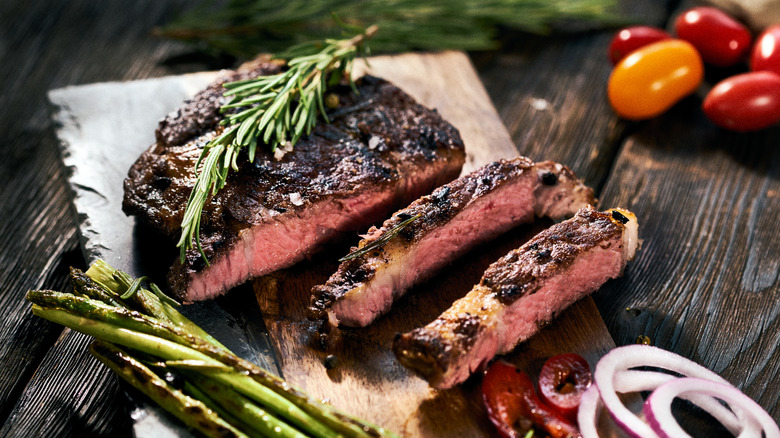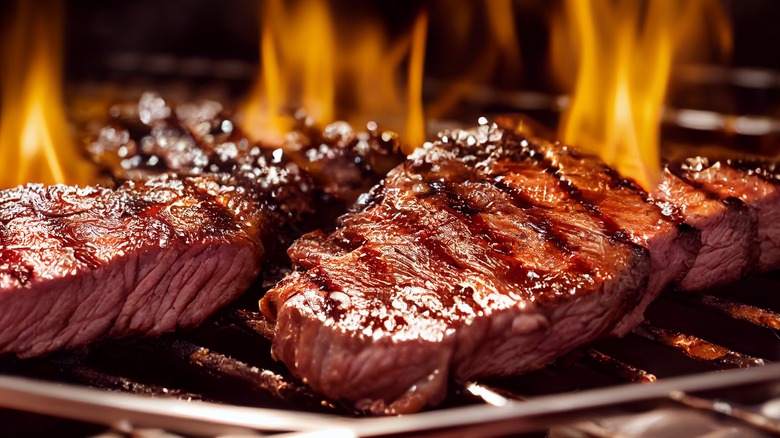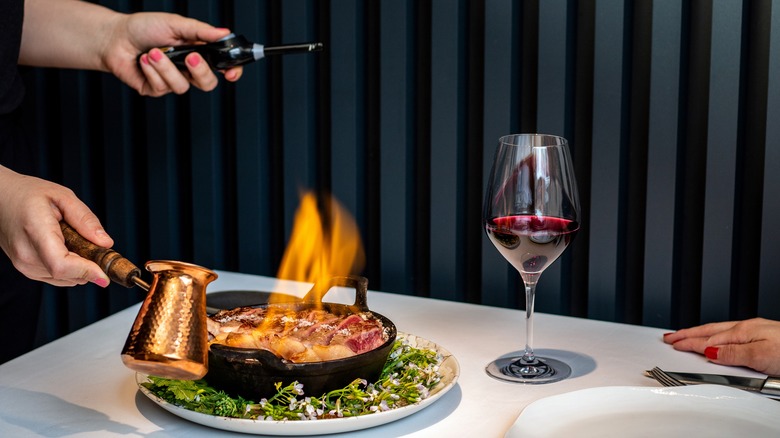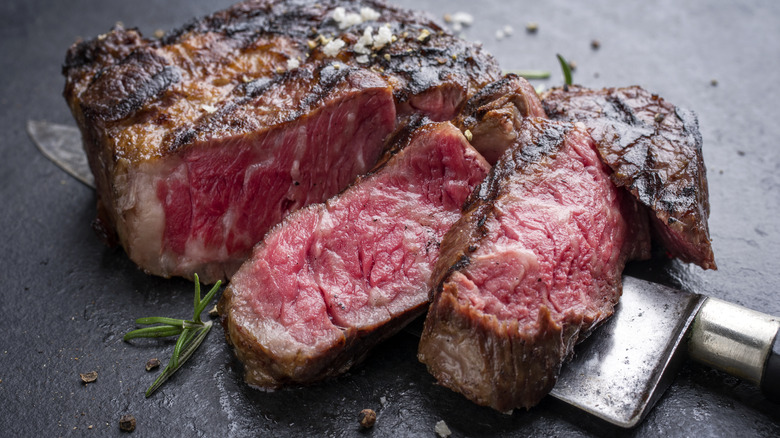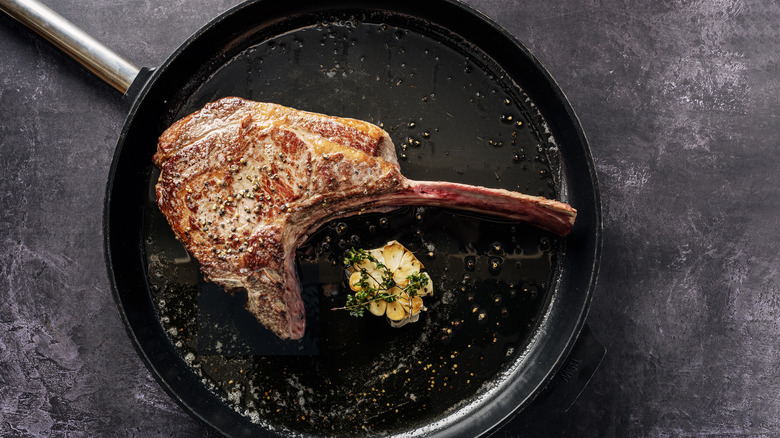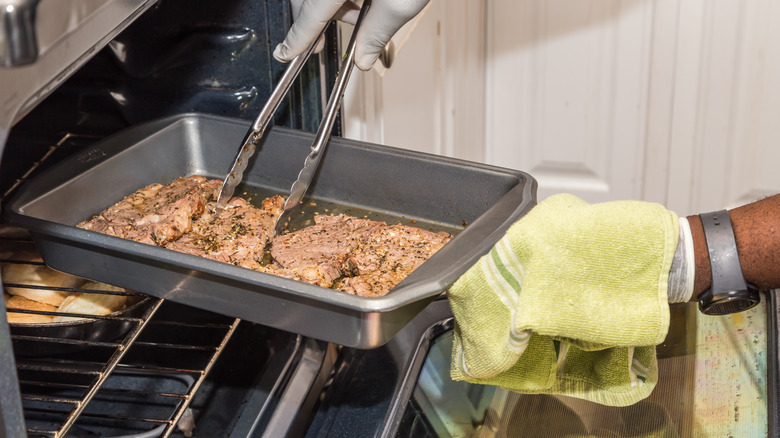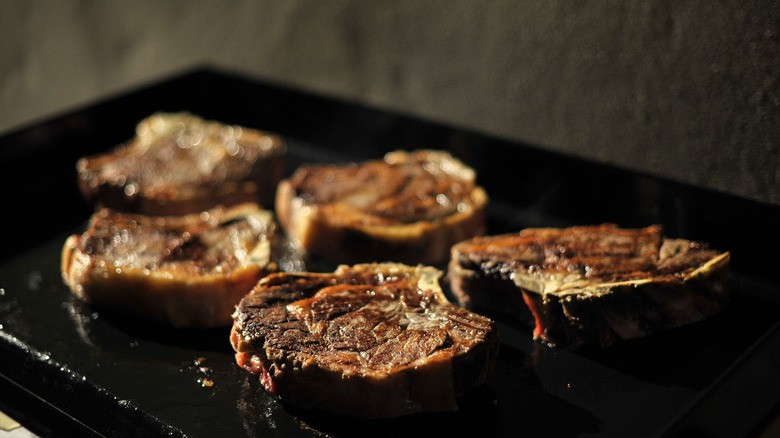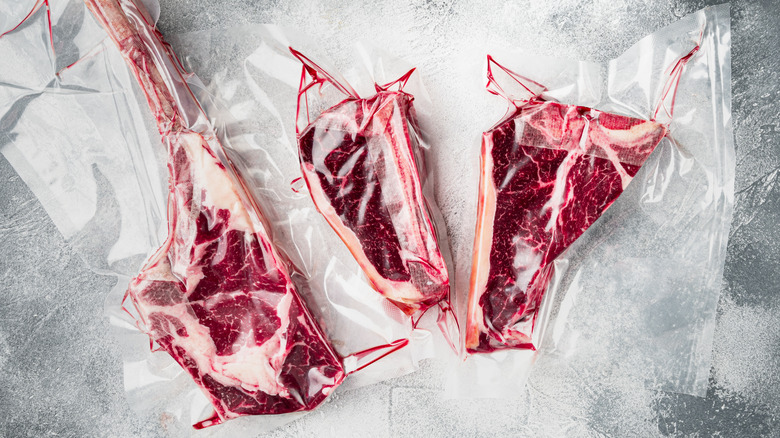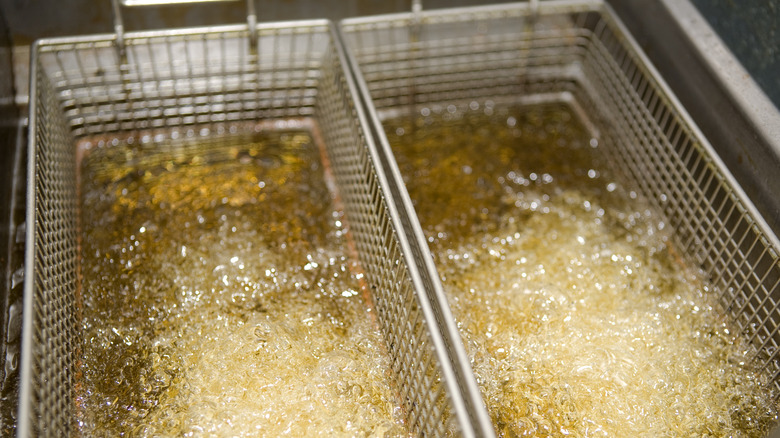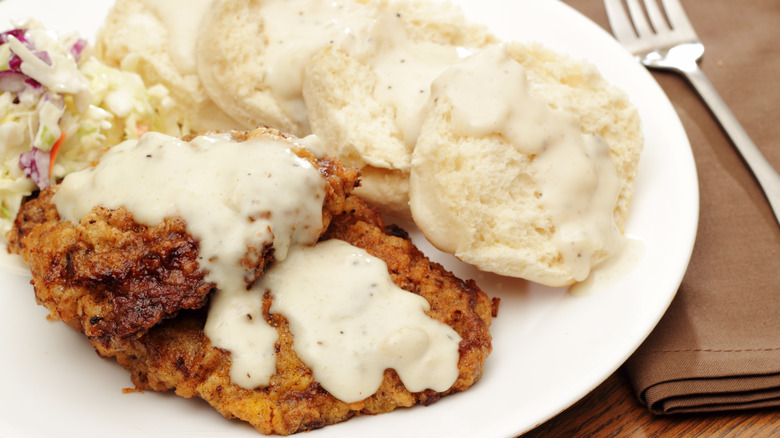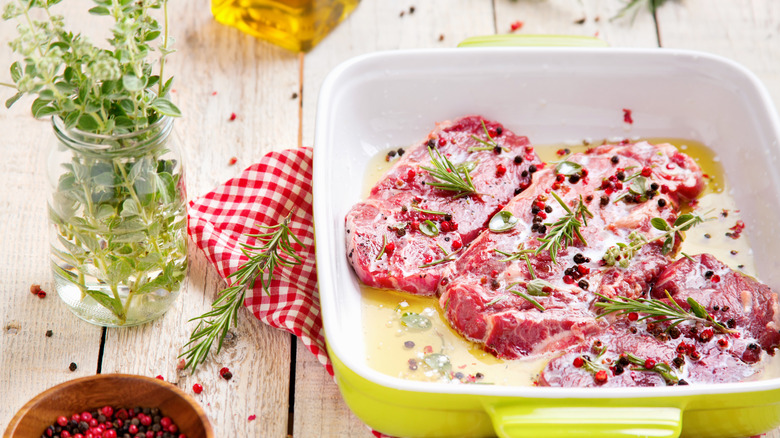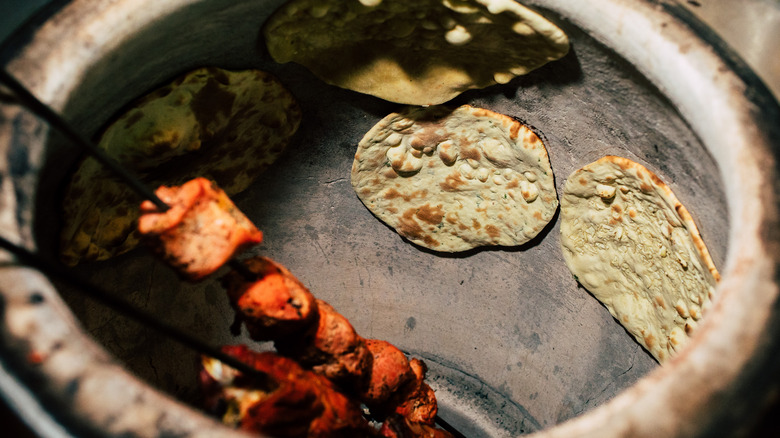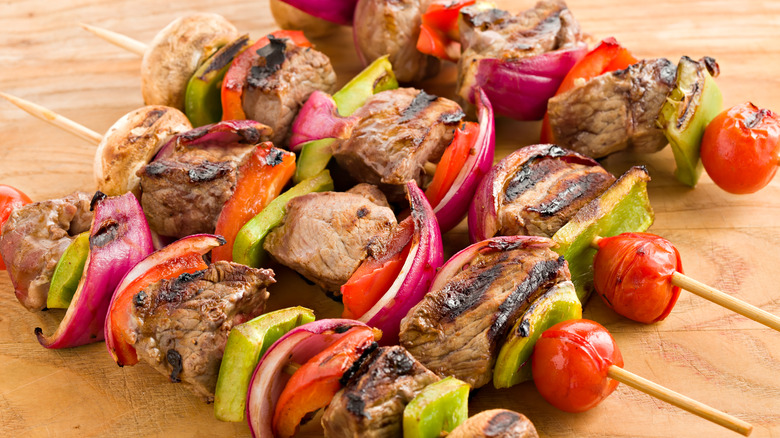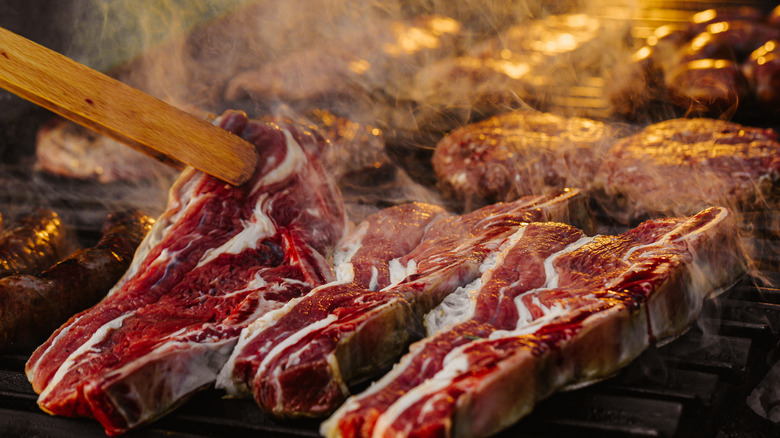How To Cook Perfect Steak 13 Different Ways
Cooking the perfect steak may seem like a simple task — after all, all you really need is a great piece of beef. But with so many different methods to attempt — from grilling to pan-searing, deep-frying to broiling — it can be easy to get overwhelmed. For Michael Tsarnas, executive chef of Gabriella's Italian Steakhouse in New Jersey, each cut of steak demands its own cooking method. "It 100% depends on the cut," echoes Kyle Kingrey, executive chef at Florida restaurant Toku. He notes that relative toughness and tenderness, not to mention thickness, can all be factors in which method to choose.
That said, there are a few general rules of thumb to which one can adhere. Katie Flannery, who with her father runs California-based Flannery Beef, a purveyor of high-quality USDA Prime dry-aged beef, notes that it's easy to overcook steak that isn't brought to room temperature first. "Everything revolves around getting the heat to the middle of the steak," she says. To this, Matt Kreider, executive chef at Steak 954 in Florida, adds one more tip gleaned from his time in pro kitchens. "At home I pan sear it to get a crispy crust and baste it with some 'love,' which is kitchen slang for things that taste good: herbs, garlic, shallot, and a nice butter."
Even with these tips in mind, however, a panoply of cooking options opens itself up to you. Here are our chefs' tips for which methods of cooking steak rule supreme.
Grilled steak
Most of our chefs agree that grilling is the best way to cook a steak. "When I'm cooking at home, it's all about grilling, grilling, grilling," says Chef David Lawrence of Goodnight's Prime Steak + Spirits in Sonoma County, California. "The grill amplifies the steak's natural fats and juices for flavor." Chef Seamus Guevara of Farmstand, the restaurant at Farmhouse Inn in Sonoma County, California, also loves the grill — particularly in summer months, when he likes cooking up thinner cuts over "a blisteringly hot grill."
That said, grilling isn't always ideal, according to Chef Matt Kreider, who notes that while it's generally his preferred method, "particularly over a good charcoal or a nice hardwood," the cut you use matters quite a bit. "Open fire grills are not always great, especially with steaks that have delicate flavors like NY strip and tenderloin," echoes Jimmy Chill, Head Chef & Culinary Director at the restaurant Branja in Miami, Florida. "The smoky flavors can easily mask the flavors of the meat."
But the reason most chefs love the grill best has nothing to do with the finished product but rather the ambiance. Indeed, when it comes to her favorite steak — a ribeye — Katie Flannery of Flannery Beef notes she almost always opts for the grill, both for the conviviality and for the easy cleanup. "I do not think it's the single best way to cook a steak," she says, "but it's one of the best."
Flambéed steak
Flambéing steak is an old-school method you'll come across in some luxe dining rooms where chefs engage in this practice not just for the flavor, but also for the flair. "Flambéing brings an element of drama to the steak's preparation," says Chef David Lawrence, noting that in restaurants where he's worked, flambéing tableside has always been "a showstopper." Chef Michael Tsarnas of Gabriella's Italian Steakhouse echoes the dramatic appeal of the technique, noting, nevertheless, that "it's not a common everyday practice."
That said, there are a few recipes where this method can be worthwhile. Chief among them is steak Diane, according to Chef Kyle Kingrey. This retro recipe sees tender beef tenderloin browned in a combination of butter and olive oil before a pan sauce of mushrooms, shallots, and garlic is created with all of that flavorful food. Cognac is added and flambéed, imparting, according to Chef Seamus Guevara, "irresistible flavor." The final sauce is enriched with mustard and cream before serving.
Indeed, Katie Flannery of Flannery Beef notes that steaks like filet are perfect for this technique. "The idea of flambé, beyond the drama, is to impart a specific flavor to the steak," she explains. "That is why I would choose the filet as it has minimum flavor of its own." And above all, be sure to do it (safely) in full view of your guests, so that they can appreciate the spectacle.
Broiled steak
Broiled steak is another retro fave, earning the No. 1 spot on Betty Crocker's list of the top 12 dishes of 1958. While broiling might not be used by many home cooks, our chefs agree that it's a go-to in a restaurant setting. "I use broilers every day," Chef Matt Kreider says. "Its' still a great cooking method that delivers a consistently great product. Want to cook a mid-rare steak in less than 10 minutes? Broil it!"
The reason why this method works so well is simple, according to businesswoman Katie Flannery: Broiling and grilling are pretty much the same technique. The only difference is where the heat is coming from. (It's no wonder the Brits call the broiler the grill.) "Not everyone has access to an outdoor grill," she says, "and I would encourage anyone with only a broiler to embrace it."
But the broiler is not just for those making do. Flannery explains that broiling gives you even more control than grilling does. Chef David Lawrence loves this method, noting it doesn't impart quite as many charred notes, letting the true flavor of the steak sing. To get the ideal result with this technique, Chef Seamus Guevara highlights the importance of choosing a thicker cut, like a bone-in ribeye, and properly tempering it before getting started. "Crack a window or two if using this technique at home," he adds. "I've been guilty of flooding my wife's bedroom closet with delicious steak aromas once too often."
Seared steak finished in the oven
If your steak is on the larger side, a double-barreled cooking method may be your best bet, according to Chef Jimmy Chill. Any steak over a pound — think tomahawks, chateaubriands, or large ribeyes — cooked over direct heat will burn on the outside before it cooks through; it's no wonder our chefs recommend pan-searing such steaks before finishing them in the oven. "Large format steaks tend to do well with this cooking method," Chef Matt Kreider says. "It's a good way to get a nice crust and a consistent cook."
Start the steak in a really hot pan — businesswoman Katie Flannery recommends cast iron, though she's also had "great success" with nonstick like Teflon. Heat up a fat with a high smoke point — Chef Seamus Guevara recommends beef tallow, grapeseed oil, or rice bran oil — and be sure not to overcrowd the pan, which will lower the oil's temperature and prevent a good sear. Once the beef is browned on both sides, finish it in an oven at 375 degrees Fahrenheit until it reaches an internal temperature of 130 degrees Fahrenheit. Be sure to let it rest before serving.
Of course, this only works if you want that caramelization and char, according to Flannery. "I believe the question of searing is really a question of visual presentation and texture," she says. "Do you like a seriously dark look to and a 'crusty' exterior on your steak? That is what you can achieve with a sear."
Reverse-seared steak
Reverse searing is all the rage these days, subverting the tried-and-true method of searing first, as detailed above. Instead, as the term suggests, reverse searing sees the steak starting in a low oven and being finished with a hard sear to get that perfectly crispy crust. But while some, like celebrity chef Andrew Zimmern, adore this technique, our experts aren't necessarily impressed.
"I don't like reverse searing," says businesswoman Katie Flannery, "because as good as I am, I'm not that good, and reverse searing is less forgiving." Because most of the cooking is done before the meat is seared, she explains, there's no room for error. "With reverse searing, you better be perfect with the front end," she says, "because you are about to apply a ton of heat at the back end — especially if you like a heavy crust."
That said, it does have its place, especially if you're prepping meat for a crowd. "Slow roasting a large cut of steak to rare and then searing hard to achieve a proper crust allows for better execution for big shareable dinners," Chef Seamus Guevara explains. Chef David Lawrence says, "It's not a method I use personally, but it's a good technique if you want to low temperature cook your meat and still want a good crust." Chef Matt Kreider notes that he sometimes uses this method at home. "It's how I make a prime rib!" he says. "It's a great way to get a restaurant product at home."
Griddled steak
Cooking steak on a flat top, griddle, or plancha renders similar results to cooking in cast iron, says Katie Flannery of Flannery Beef. And while she doesn't typically cook her steak this way, she has no qualms with the technique, in theory. Chef Jimmy Chill of Branja is far more enthusiastic, dubbing it his favorite steak-cooking method. "Cooking steak this way gives it a beautiful crust, while still juicy and tender inside," he says, noting all you need is a touch of vegetable oil, salt, and pepper for steaks to really sing on the plancha. "While truly it depends on the cut, this works for 70% of cuts."
Chefs Matt Kreider and Kyle Kingrey don't prefer this method, with Kreider noting "there are better ways." But Kingrey says that "sometimes the kitchen layout dictates it." Chef Seamus Guevara notes that it's a go-to for those with smaller pro kitchens, such as those on food trucks. And Chef David Lawrence says he, too, has used a griddle in a pinch while camping.
"Slow-cooked Chicago-style chipped beef sandwiches, like the one from the now infamous TV show 'The Bear,' are finished this way," Guevara adds. "This technique allows a cook to quickly sear a lot of sliced beef at once as the orders roll in." Ultimately, however, Kingrey said he believes the griddle is far better for burgers than for steaks.
Sous-vide steak
Cooking steak sous-vide is yet another method growing in popularity among those who like to add a touch of technical flair to their culinary stylings. It sees the steak vacuum-sealed into a plastic pouch and cooked in water at a relatively low temperature — around 130 degrees Fahrenheit — which basically renders overcooking impossible. "The benefit of sous-vide cooking a steak is that it comes out the temperature you want it to every time," Chef David Lawrence says. "If you're not used to cooking steaks all the time and able to accurately cook to a preferred temperature, the effort of sous-vide cooking does pay off."
That said, according to Chef Michael Tsarnas, what you gain in temperature control, you lose in texture. "It's definitely worth the effort for a consistently tender steak," he says, "although I love the flavors that develop when searing a steak." The benefits, according to Chef Matt Kreider, are most palpable if you're looking to add more fat or flavor, seeing as you can seal seasonings and aromatics into the pouch with the steak.
Chef Kyle Kingrey adds, "This is a good option for infusing herbal flavors into the steak. Personally, I like using other methods for reverse searing." But Katie Flannery of Flannery Beef is of the opposite opinion, noting that sous-vide "encompasses the reverse-sear concept, solving my concern that if you are not perfect on the front end, a reverse sear can overcook it — sous-vide assures you the front end is correct."
Deep-fried steak
Deep-frying steak may strike you as odd, but it's actually yet another on-trend method experts love for a foolproof crispy crust. Some recipes, like chicharron de ribeye or deep-fried wagyu, really lean into this maximalist approach. That said, the novelty of it doesn't convince many of our experts. "Honestly can't think of why [I would]," Flannery Beef's Katie Flannery says.
"I would never deep-fry a steak," echoes Steak 954 Executive Chef Matt Kreider, noting, nevertheless, that's he's been "intrigued" by approaches at Japanese steak houses, where A5 grade wagyu is battered in tempura and deep-fried. Chef Kyle Kingrey notes that at his Toku restaurant, some of the steaks are deep- or shallow-fried.
Chef David Lawrence of Goodnight's Prime Steak + Spirits says he, too, has relied on shallow-frying on occasion for the perfect steak. "If I am cooking in the house, I would shallow-fry my steak in a black skittle pan or a French Le Creuset pan," he says. "This is especially helpful if I wanted to make a pan sauce to serve with it. I would add diced carrots, shallots, herbs, red wine, and stock to the pan after cooking the steak."
Chicken fried steak
Chicken fried steak is perhaps one exception to the rule precluding our experts from deep-frying their steaks. "I grew up in the mountains of North Carolina, so personally I like chicken fried steak," says Chef Kyle Kingrey, noting that this dish is typically made with chuck steak that has been tenderized. It's then breaded in a seasoned mix of flour and cornmeal before being deep- or shallow-fried and served with a white gravy — often, Kingrey says, for breakfast.
This is, however, a fairly regional specialty, and it can be tough to get behind if you're not used to it. "Chicken fried steak has never appealed to me," Chef David Lawrence says. "It's not a dish I ever grew up with in England."
Katie Flannery of Flannery Beef also did not grow up with the dish. "I can probably count on one hand the number of times I've had it and have never cooked it myself," she says. If she did, however, she says she'd probably trade up from the more common top or bottom round to a top sirloin. "It will be a little more expensive — but only just a little," she says. "The end result using sirloin will be a factor of two or three better." Chef Matt Kreider is all in favor of adding a bit more luxury to this cut. "I recently chicken-fried a wagyu ribeye for fun," he says. "It was one of the best things I've eaten."
Marinated steak
Marinating steak isn't necessarily a cooking method, but it can be an essential way of adding tenderness and flavor to steak. "Marinades are irreplaceable for cuts such as skirt steak, cross-cut short ribs, flank, and hanger steak since the striated nature of those muscle fibers allows for wet marinades to be absorbed quickly and efficiently," Chef Seamus Guevara of Farmstand says. "This imparts a level of flavor impossible to achieve in these cuts otherwise." He particularly loves marinating skirt steak in an asada-style blend of orange zest, orange juice, lime juice, salt, manzano peppers, wild herbs, and beer. And he's also a fan of marinating cross-cut short ribs kalbi-style, with tamari, ginger, scallions, kukotu, and green garlic.
Chef David Lawrence agrees, noting that very lean steaks, like flank steak, tend to naturally have less flavor than well-marbled ones. In these cases, he says, "a marinade provides a needed flavor punch."
That said, not all steaks need a marinade. "Top tier steaks (ribeye, New York, filet) I would never marinate, period," Katie Flannery of Flannery Beef says. And while she agrees that some cuts like skirt or hanger do benefit from a marinade, she admits she likely wouldn't use one, adding, "I'm a bit of a purist. Just salt and pepper is sufficient for me."
Tandoori steak
Tandoori may first bring to mind Indian spices, but a tandoor is actually an oven — and a very hot one at that. A tandoor blends convection, smoke and ripping hot temperatures of up to nearly 900 degrees Fahrenheit for a totally unique cooking method that imparts a lovely smoky flavor to your steak. And given the high heat of such a beast, Chef Matt Kreider has no doubt that it would work well for cooking steak. "I haven't done it personally, but I wouldn't be averse to the idea," he says. "That level of heat would create quite the crust."
Of course, this doesn't work for all steaks. In areas of India where beef is eaten, such as in Goa, or in neighboring countries with no preclusion against beef, like Pakistan, beef is typically formed into patties or cooked on skewers.
"The tandoor oven is very hot, so it is best for quick cooking meats," Chef Kyle Kingrey explains. "A thinner ribeye or a skirt steak are great this way as well."
Steak shish kabob
If you're feeding a crowd in summertime, there's perhaps no better approach than grilling steak kabobs or brochettes. "This cooking technique primarily allows for smaller cuts to be grilled evenly and requires no slicing afterward," Chef Seamus Guevara says. Depending on the cut you use, they can be a real treat. Flannery Beef's Katie Flannery recommends opting for tender cuts like filet, top sirloin, or tri tip. "If possible to source, filet tips or tails are a very affordable alternative to a high-priced filet," she says.
Picanha is another option she recommends, something that Chef Matt Kreider notes is quite common in South Florida but is also beloved throughout Latin America and specifically in Brazil. "The biggest concern is proper spacing with all your ingredients so they cook properly," Kreider says.
And that's not the only technical tip our experts have to offer when it comes to kabobs. Flannery notes that it's imperative to trim away any nerve or facia you may see, which will contribute to a tougher texture. And Guevara recommends marinating the steak before skewering. The steak isn't the only thing you should soak, according to Chef David Lawrence. "The one tip I tell everyone is to soak your skewers in water before use, so they don't burn while the meat cooks," he says.
Smoked steak
Barbecue has a long tradition in the South, and in Texas, beef is king. "Ever had smoked brisket or short rib?" Chef Matt Kreider asks. "It's awesome!"
Smoking works particularly well with these cuts given how long it takes them to cook through perfectly. These cuts, which hail from muscles that get quite a bit of work, have loads of collagen running through them. The low-and-slow technique of smoking can help break down this collagen, rendering the meat tender, juicy, and filled with lovely smoky flavor.
But in addition to the smoked brisket the Lone Star State is known for, smoking is also one of our chefs' favorite ways of cooking a steak. "Smoking a whole striploin or ribeye to rare and then cutting the steaks and grill or sear them is a favorite of mine," Chef Kyle Kingrey says. The steaks can be smoked at 180 degrees Fahrenheit for about 20 minutes before finishing on the grill over high heat for that perfect crispy crust.
